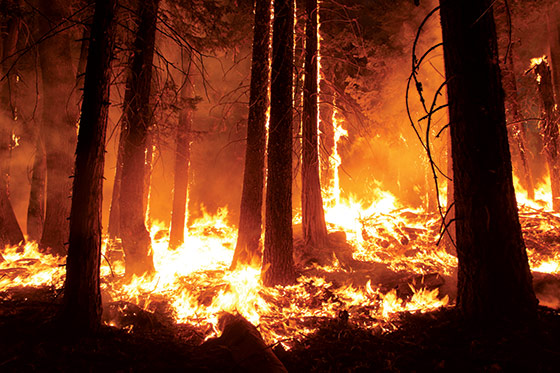 |
(Photo: Mike McMillan/Spotfire Images) |
It is famous for fire, but you get there by water, six miles down a stretch of the Missouri that ran fast until it was dammed a hundred years back and 20 more miles downstream. Now it runs slow, and the limestone cliffs that line it double their height in its quiet surface. Wherever they offer a foothold, a fir or pine has found it. The sky is so clear it looks like a mind that has never once thought about clouds. Everywhere you turn, the world is blue, granite, and green, the national flag of the wilderness on good behavior.
The boat guy is named Tim, and as he heads downriver to our destination, he tells me about the other people he has taken there, Oliver Stone, Stephen Ambrose, gifted kids in writing classes, underprivileged kids in outdoor programs, corporate types on leadership trainings, Forest Service higher-ups, hotshot crews, guy by the name of Laird Robinson, guy by the name of Bud Moore, relatives of the victims, and, twice, the only remaining survivor. Not that there were many in the first place.
Outdoorspeople are as varied as any other kind, except that they share one psychological stratum, a layer hard and fine laid down as in geology by the pressure of the Earth. Tim is affable and talkative and has smashed open two of the knuckles on his left hand recently enough to show fresh blood and flecks of white, and not once in an hour does he glance down at them. He was born in Helena, moved away as an adult to Arizona, wondered why, and came back. Now he manages a company that has taken people down this river since 1886, three years before Montana became a state. Some of his clients come to retrace the footsteps of Lewis and Clark, who, on July 19, 1805, “entered much the most remarkable clifts that we have yet seen.” Others come for the remarkable clifts themselves, others to fish the waters beneath them. But some come, as I have, to visit the site of the most famous wildfire in American history.
The world is stitched together along strange seams. In 1905, Orville and Wilbur Wright got a flying machine aloft and kept it there for 39 minutes. That same year, Teddy Roosevelt signed the act that brought the United States Forest Service into being. In 1939, the USFS launched its smoke-jumper program, which deploys firefighters to wildfires by plane and parachute. In 1949, 15 of those smoke jumpers stepped out of a C-47 to extinguish a fire burning above the Missouri River in a place in central Montana called Mann Gulch. No one remembers who Mann was anymore. The word gulch sides with breach and gap and hollow against its Latinate counterparts, canyon and valley and ravine. It comes from early English, which, in our English, often signals the humble and the primal: home, hearth, birth, child. Etymologically, it means “to swallow.” Two hours later, 11 men were dead.
Two more would be gone by morning, bringing the toll to 13. But the Mann Gulch fire is not famous because it was exceptionally lethal or large or destructive, or because it single-handedly changed public perception and policy around wildfires. It was none of those and did none of that. The families buried their dead and, figuratively speaking, the Forest Service did much the same. For the better part of 50 years, not much came out of Mann Gulch, and not many went in.
Then, a quarter-century after the last embers sank to black, a 73-year-old retired professor of Renaissance literature at the University of Chicago started writing a book about Mann Gulch. He worked on it for 14 years and died at 87 before he could quite bring himself to call it finished. His name was Norman Maclean. The book was Young Men and Fire. Published posthumously in 1992, it hit the best-seller list, won the National Book Critics Circle Award, became a cult classic among literati and a regular classic in the fire community, shaped the culture and practice of wilderness firefighting, and turned a remote hillside into an outdoor classroom and place of pilgrimage. It was Maclean’s book, not any act of nature, that give America its signature wildfire.
In the years since that book came out, the cost of controlling wildfire in the United States has risen from $240 million to almost $2 billion. When Maclean began working on it, in the 1970s, fires burned an average of 200,000 acres per year. So far in 2014, they have burned 2.7 million. Since January, 100 percent of the state of California has been in severe drought, and new research suggests it could stay that way for the next 50 years.